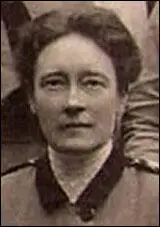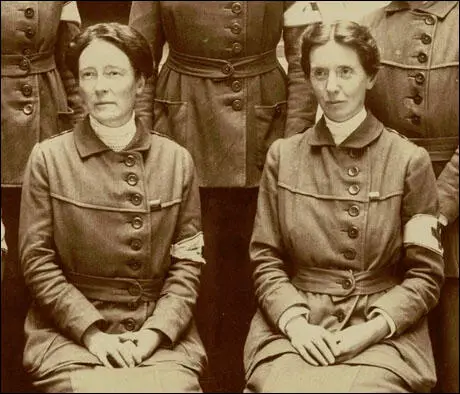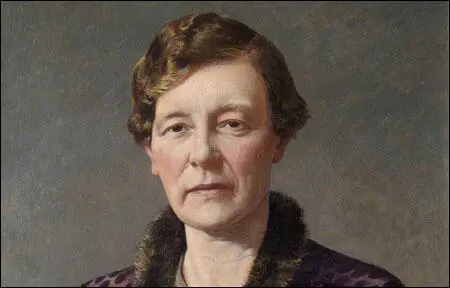Louisa Garrett Anderson

Louisa Garrett Anderson was born on 28th July 1873. Her father, James George Skelton Anderson, was a co-owner of the of the Orient Steamship Company. Her mother, Elizabeth Garrett Anderson, had become the first woman to qualify as a doctor. Both her mother and her aunt, Millicent Garrett Fawcett, were leading figures in the National Union of Women's Suffrage Societies.
Louisa was initially educated at home where one of her tutors was the feminist, Hertha Ayrton. Later she attended St Leonards School and Bedford College before entering the London School of Medicine for Women. She qualifying as a surgeon in 1897. Louisa was also active in the struggle for the vote and in 1903 she became chair-person of the Fulham branch of the NUWSS. However, she became very frustrated by the lack of progress in getting the vote and in 1907 she joined the Women Social & Political Union.
Evelyn Sharp spent time with Louisa and Elizabeth Garrett Anderson at their cottage in the Highlands: "Her daughter, who brought the same gifts of courage and perception, so rare in combination, to the service of the same cause, inherited all her mother's brains and culture, and more than her personal charm and gentleness. Her friendship was one of those I gained at that troublous time, and it offered generous compensation for many losses."
In October 1909 the Tax Resistance League was founded at a meeting at her flat in Harley Street. She also led the Medical Women Graduates section of the WSPU procession held on 21st June 1910. Anderson was arrested during a protest at the House of Commons in November but was released without charge.
In March 1912 the WSPU organised a new campaign that involved the large-scale smashing of shop-windows. May Billinghurst agreed to hide some of the stones underneath the rug covering her knees. According to Votes for Women: "From in front, behind, from every side it came - a hammering, crashing, splintering sound unheard in the annals of shopping... At the windows excited crowds collected, shouting, gesticulating. At the centre of each crowd stood a woman, pale, calm and silent." Louisa Garrett Anderson was arrested during this demonstration and was sentenced to six weeks in Holloway Prison.
Millicent Garrett Fawcett was upset when she heard the news and wrote to her sister, Elizabeth Garrett Anderson: "I am in hopes she will take her punishment wisely, that the enforced solitude will help her to see more in focus than she always does." However, the authorities realised the dangers of her going on hunger strike and released her. In a speech she made on 18th April 1912 she announced she had been released because "the Home Office found that I might like to spend Easter with my family." She sent a letter to the British Medical Journal complaining about her preferential treatment.
Louisa Garrett Anderson was involved with Flora Murray and Catherine Pine in running the Notting Hill nursing home that WSPU members went to while recovering from hunger strikes. In 1912 she joined with Murray to establish the Women's Hospital for Children in the Harrow Road.
The summer of 1913 saw a further escalation of WSPU violence. In July attempts were made by suffragettes to burn down the houses of two members of the government who opposed women having the vote. These attempts failed but soon afterwards, a house being built for David Lloyd George, the Chancellor of the Exchequer, was badly damaged by suffragettes. This was followed by cricket pavilions, racecourse stands and golf clubhouses being set on fire.
Some leaders of the WSPU such as Emmeline Pethick-Lawrence, disagreed with this arson campaign. When Pethick-Lawrence objected, she was expelled from the organisation. Others like Louisa Garrett Anderson and Elizabeth Robins showed their disapproval by ceasing to be active in the WSPU. Sylvia Pankhurst also made her final break with the WSPU and concentrated her efforts on helping the Labour Party build up its support in London.
On 4th August, 1914, England declared war on Germany. Two days later the NUWSS announced that it was suspending all political activity until the war was over. The leadership of the WSPU began negotiating with the British government. On the 10th August the government announced it was releasing all suffragettes from prison. In return, the WSPU agreed to end their militant activities and help the war effort.

During the First World War a group of wealthy suffragettes, including Janie Allan, decided to fund the Women's Hospital Corps. Louisa Garrett Anderson joined forces with Flora Murray to run a hospital in Claridge Hotel in Paris. Fellow WSPU member, Evelyn Sharp, who visited them in France, remarked: "It was in a way a triumph for the militant movement that these two doctors, who had been prominent members of the W.S.P.U., were the first to break down the prejudice of the British War Office against accepting the services of women surgeons." In February 1915 Anderson and Murray took charge of the Endell Street Military Hospital in London. Anderson was chief surgeon and the hospital treated 26,000 patients before it closed in 1919.
After the passing of the Qualification of Women Act the NUWSS and WSPU disbanded. A new organisation called the National Union of Societies for Equal Citizenship was established. As well as advocating the same voting rights as men, the organisation also campaigned for equal pay, fairer divorce laws and an end to the discrimination against women in the professions.

Anderson lost her early radicalism and joined the Conservative Party. In 1934 she became a justice of the peace and later became the mayor of Aldeburgh, Suffolk. She never married and was the constant companion of Flora Murray until her death from rectal carcinoma in 1923.
During the Second World War Anderson joined the surgical staff at the Elizabeth Garrett Anderson Hospital. In 1943 she was found to have disseminated malignant disease, and was taken to a nursing home in Brighton, where she died on 15th November 1943. Louisa was cremated and her ashes scattered locally, but her family arranged for an inscription commemorating her friendship and work with Flora Murray to be placed on the latter's tombstone in the churchyard at Holy Trinity Church near to her home in Penn, Buckinghamshire.
Primary Sources
(1) Evelyn Sharp, Unfinished Adventure (1933)
There were occasional, very occasional, holidays at home during the years of the suffrage agitation. Two that stand out especially in my memory were spent at Newtonmore in Inverness-shire. Here I was the guest of Dr. Elizabeth Garrett Anderson, who had a summer cottage in that beautiful part of the Highlands. I went there on both occasions with her daughter Dr. Louisa Garrett Anderson, and we had great times together climbing the easier mountains and revelling in wonderful effects of colour that I have seen nowhere else except possibly in parts of Ireland. Only those who were engulfed in the preoccupations of those militant years could appreciate what it meant to us to get away from it all for a week or two, although our peace was twice invaded by the campaign we thought we had left behind, when Mrs. Fawcett (my hostess's sister) and Mrs. Pankhurst stayed with us, each in the course of conducting a speaking tour. It was, however, so entertaining to meet both these famous public characters in the more intimate and human surroundings of a summer holiday that we did not grudge the time given to working up a suffrage meeting in the village instead of tramping about the hills.
Old Mrs. Garrett Anderson-old only in years, for there was never a younger woman in heart and mind and outlook than she was when I knew her before the war was a fascinating combination of the autocrat and the gracious woman of the world. I thought one of her brothers summed her up rather delightfully, one day, when, contrary to everybody's entreaties and advice, she insisted on clambering down a steep incline under the unshakable impression that it was a short cut home. "You must make allowances, I suppose, for her being the first woman doctor," he observed, when she had had time to realise her error and he was setting off to fetch her back. Undoubtedly, like Florence Nightingale and other reformers who have had to fight both prejudice and vested interests, if Elizabeth Garrett Anderson had been the sweetly reasonable person who always believes what she is told without questioning it, she would not have been the pioneer who opened the medical profession to women. In her own home she was a most hospitable and lovable hostess, and had a delicious sense of humour, which may have been one reason why she was instantly attracted towards the militant branch of the suffrage movement when it became prominent. Her daughter, who brought the same gifts of courage and perception, so rare in combination, to the service of the same cause, inherited all her mother's brains and culture, and more than her personal charm and gentleness. Her friendship was one of those I gained at that troublous time, and it offered generous compensation for many losses.
There was a strong family likeness in all the Garretts ; and their fine sterling qualities, added to much that was personally attractive, made me feel proud to be a member of the house party that included three of the sisters of the older generation. Miss Agnes Garrett used to accompany Mrs. Fawcett everywhere, and when they both joined us at Newtonmore, the conversation became noticeably more racy, enlivened as it was with many excellent anecdotes gathered in their wanderings about the world. Nothing seemed to daunt these doughty women, and although I have always rather prided myself on wearing suitable clothes and yielding easily to the demands of a simple country life, I felt nothing but an artificial inhabitant of cities when I saw them tuck up their skirts - there was plenty to tuck up in those days - and don indescribable boots, before starting out to brave inclement weather and face really difficult rambles in the mountains above Speyside. I wondered sometimes if, thirty or forty years later, I should be able at the same age to show half their energy and unassailable good health.
(2) Evelyn Sharp, Unfinished Adventure (1933)
I crossed the Channel only once, and that was soon after war broke out, when I spent a week-end in the British hospital run by Dr. Louisa Garrett Anderson, with Dr. Flora Murray, at Wimereux near Boulogne. It was in a way a triumph for the militant movement that these two doctors, who had been prominent members of the W.S.P.U., were the first to break down the prejudice of the British War Office against accepting the services of women surgeons. Under the name of the Women's Hospital Corps they had to work first with the French Red Cross, who felt no such prejudice and allowed them to establish a hospital for wounded soldiers in the Hotel Claridge, Paris. Here, in addition to French wounded, there were some British cases; and when the same women secured permission to open another hospital in the Chateau Mauricien at Wimereux, it was recognised as a voluntary hospital by our own War Office and received only British wounded. This was a prelude to the establishment of the Women's Military Hospital in Endell Street, London, which was under the command of these two doctors and remained open till after the war was over.

